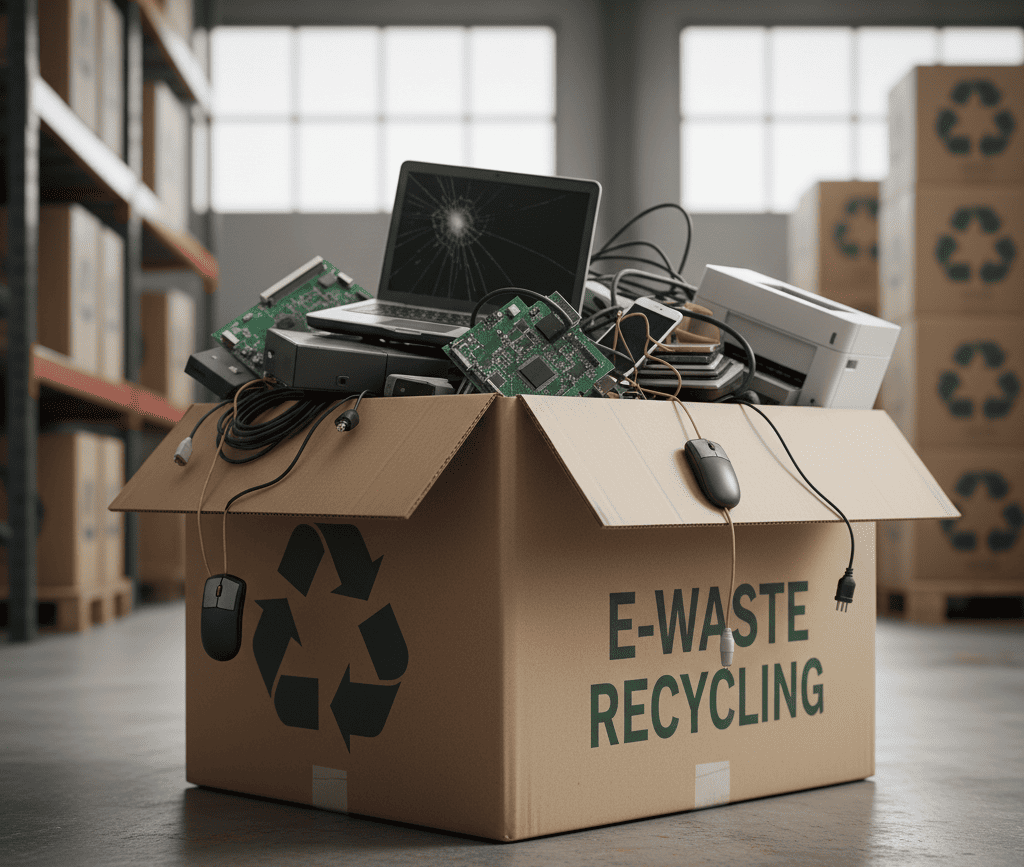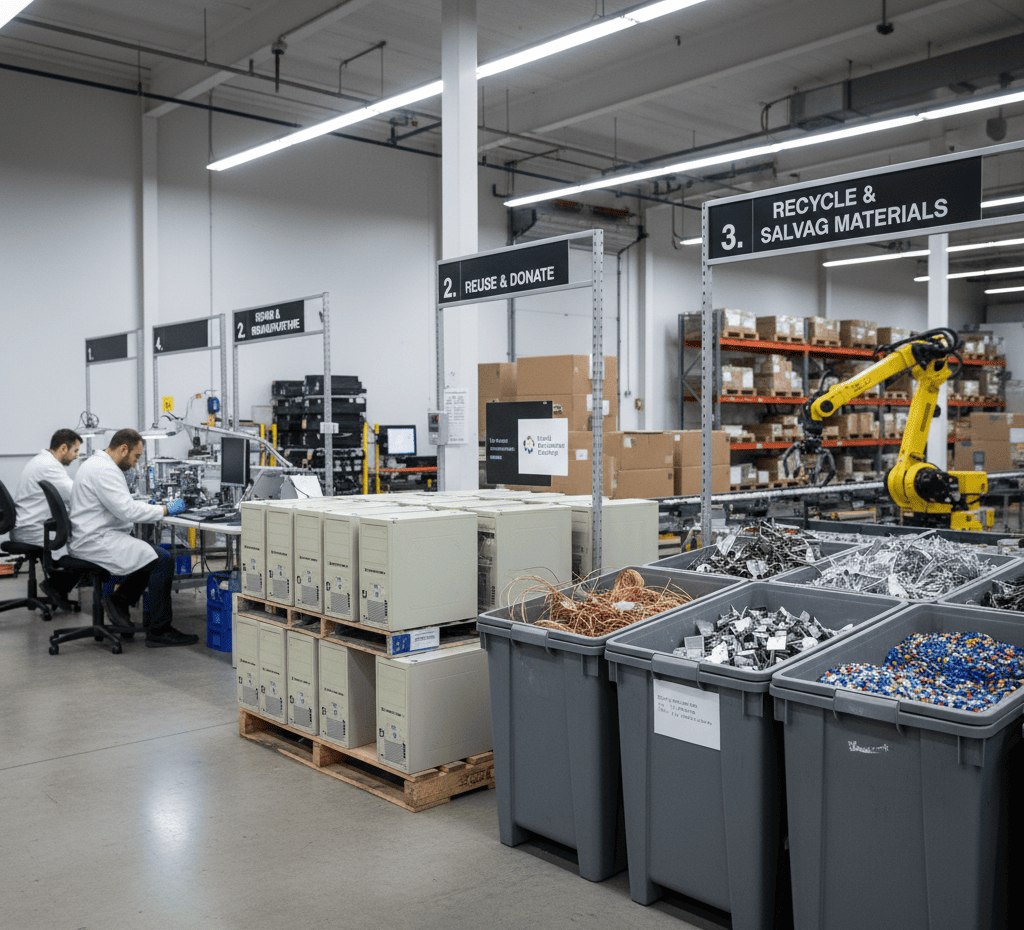Business sustainability is an ideal that many organizations seek as part of their long term goals. In the same realm, electronic waste has become nothing short of a crisis in the corporate world.
But what does e-waste have to do with sustainability in business?
The United Nations reports that 20-50 million metric tons of e-waste is discarded every year. Any electronic equipment that has been thrown away like computers, cell phones, and printers fall into that category.
Businesses are responsible for a sizeable percentage of the world’s electronic waste and it’s not a difficult task to imagine why. For this reason, recycling of computers, printers, cell phones, and other IT equipment should be an integral part of a business’ sustainability agenda.
If your organization seeks to make a real shift in that direction, e-waste recycling is the first and most consequential move.

Most people, including business owners, harbor several misconceptions about what sustainability really is.
Is it all about the environment? Not at all.
It is an expensive agenda to push? Certainly not.
Is it more hassle than it’s worth? It’s a small effort for a large reward.
There is a distinct economic advantage for businesses who espouse a culture of sustainability throughout their daily operations.
The initiative is geared towards meeting the triple bottom line of a business, namely:
● Financial
● Ecological/Environmental
● Social
So why is the recycling of electronic equipment the best way to contribute to that triple bottom line?
1. Save Money For Your Business: There are several organizations who have made e-waste their business. They collect all end-of-cycle IT equipment and some provide a cash back. This extra money can be used to finance replacement tech for your business or any other financial goals.
The fiscal benefits also extend to the Tech Industry. According to James Allen, Director of EPEAT, if the recycling of gold, silver, and platinum increases to 100%, the Electronic Sector will have a 12 billion dollar financial and natural capital advantage.
2. Create Employment: Out of the 90 % of recyclable e waste, only 12.5 % is recycled. If that gap were to be bridged, companies who recycle and refurbish old electronics would require an increase in manpower. This would result in a rise in job creation on a mass scale.
3. Conserve Natural Resources: The valuable materials collected from recycled electronics can go towards creating other products.
For example, palladium is a metal that can be used to create surgical instruments, watches, and other electronics. Copper, silver, and gold are among the other precious metals that can be recovered.
4. Protect The Health of The Environment: Toxic elements like mercury, chromium, and lead can find their way into the environment when electronics are not recycled the right way. This has grave repercussions for public health.
5. Support The Less Fortunate: Naturally, businesses want superior technology to increase their output and maximize their efficiency. The outdated technologies can be refurbished and donated to schools, nonprofits, and others who need it.

We’ve already pinpointed the recycling of electronics as one of the primary means of achieving sustainability in business. But, there are many layers and nuances to e-waste recycling.
Here’s a basic hierarchy:
Repair and remanufacture of entire units – Many electronics are disposed when they only have a simple malfunction. These problems can usually be fixed to extend the life cycle of the entire unit.
Reuse of what’s functional – In some cases, the electronic in it’s entirety may not be viable but some components can still be used. Your business can also donate unwanted computers to an organization like World Computer Exchange that will get them in the hands of those who need it most.
Recycling of what cannot be repaired – If certain parts or whole electronic units are beyond repair, they can be recycled to salvage the valuable materials.
Responsible disposal of what can’t be recycled or reused – About 10 % of e-waste cannot be recycled. Every effort should be made to get these disposed in the proper disposal sites so hazardous elements like lead don’t make its way into our water and airways.
This list is by no means exhaustive but these are the common ones relevant to businesses. They include:
● Desktop and Laptop Computers
● Monitors, Televisions, and Other Display Devices
● Keyboards, mouses, and other computer accessories
● Printers, photocopying machines, and Ink/Toner Cartridges
● Cellphones & Pagers
● Fax Machines and Telephones
● Audio Devices

The prolific e-waste problem has led to the emergence of many waste management and electronic recycling organizations.
Let’s get into the solutions that are out there.
1. Take Back Programs – A plethora of businesses and manufacturers have their own recycling initiatives where you can turn in unwanted electronics.
Many offer rewards like gift cards, credit, and cash. Some of the notable programs include:
● LG Electronics Recycling Program
2. Many States Have Their Own E- Recycling Solutions – Your business can conduct a local search to find the programs that have been put in place for your particular state or city. Kansas city, for example, has an e-waste grant program. A simple google search would be “E Waste Recycling [Name of Your State/City]”.
3. Donations To Nonprofit Organizations – Organizations like EWaste4Good help businesses to donate their electronics with ease. It’s a simple process where they come to your place of business to collect the unwanted equipment at no charge.
3. Professional E Waste Disposal Facilities – There are companies with specific licensure for the proper disposal of e-waste. For instance, The Coalition for American Electronics Recycling (CAER) has more than 130 companies as signed members.
You can also find companies that have been vetted through e-stewards.org.

E-waste is a critical problem both in the corporate world and on the global scene. However, if every business looked at their sustainability initiative as a way to contribute to their business’ bottom line, the problem would be half solved.
Take a look at the specific electronic use and subsequent wastage in your organization and select the recycling methods that best suit your needs. The solutions are there and the benefits to your business are clear.